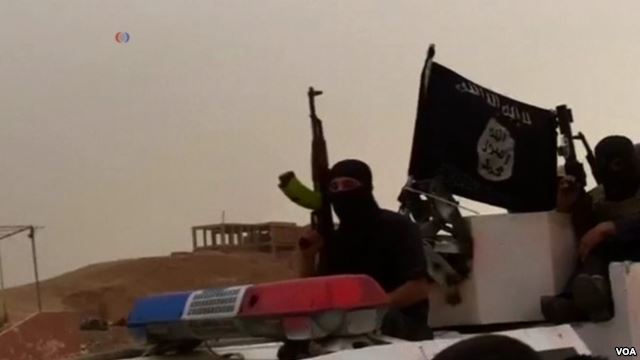
‘Our People in an Alien War’: Kazakhstanis Fighting for the Islamic State
Publication: Eurasia Daily Monitor Volume: 11 Issue: 206
By:

In late September 2014, Erlan Karin, the newly appointed director of the Astana-based Kazakhstan Institute for Strategic Studies, presented a report on Central Asians fighting for the Islamic State (IS—formerly known as the Islamic State of Iraq and Syria, or ISIS) called “Our People in an Alien War: Central Asian Fighters in the Syrian conflict” (Nashi lyudi v chuzhoy voyne: tsentral’no-aziatskiye boyeviki v siriyskom konflikte).
According to the report, among foreign jihadists within IS, 250 are nationals from Kazakhstan, 100 come from Kyrgyzstan, 190 are from Tajikistan, 360 from Turkmenistan and more than 500 originate from Uzbekistan. The official figures presented by the region’s special services, however, assume smaller numbers (Tengri News, September 16). In fact, concrete and accurate numbers of jihadists from each Central Asian republic are nearly impossible to determine with any certainty. Just as difficult has been trying to ascertain how many of these fighters are already dead or captured. According to local experts, up to 80 percent of Kazakhstani jihadists for IS might already be dead (Megapolis, September 22, November 3).
That said, not only is the number of Kazakhstani nationals leaving for Syria growing, but their recruitment areas have expanded as well. While in the past, the fighters tended to come from southern Kazakhstan, now they are also coming from Karagandy (central Kazakhstan), Aktobe (northwestern Kazakhstan) and Western Kazakhstan oblasts (Tengri News, September 16).
As the report highlights, the age of Kazakhstani jihadists ranges from 19 to 43. On average, they are in their early 30s. Most have a higher education and a relatively stable job, and most were married and had young children. These potential jihadists are notably extremely pious: they maintain Muslim traditions and abide by the Koran’s laws (Radiotochka.kz, September 16). Apparently neither their families nor friends were able to detect when they crossed the line into radicalism.
Throughout 2014, several accounts confirmed that some Kazakhstani jihadists left the country together with their families, including pre-school and school-age children. Muhamedkali Danikhanov, from Kengyr village, who had visited his son and his family in Iraq this year, was told that Kazakh jihadists harbored no plans of returning to Kazakhstan, where they would face criminal trials. Danikhanov refused to disclose the exact route his son and others used to reach their current location, but made it clear that they now reside on Iraqi territory around the Baghdad area (Azattyq, September 11).
In many previous cases, young people (potential recruits) claimed to their friends and families that they were traveling to Egypt to undertake Islamic theological studies; but their real destination was Syria, which they reached via Turkey. In most cases, such young people originally lived away from their immediate families, which made it harder to monitor their actions and way of thinking. Many had started down the path toward radicalization by listening to dubious preachers (Megapolis, August 4) or by being inspired by things they read on social media. As the media outlet Azattyq revealed in its interviews with Kazakhstani jihadists’ families, the family members are initially in denial, but after learning the truth, they often go to the authorities with information regarding their children in the hopes of having them returned home. If their children do return home, however, they remain silent about their experiences fighting with IS, fearing public embarrassment to themselves and their families as well as other unnecessary attention—including from the authorities (Azattyq, November 5).
In response to this growing phenomenon of Kazakhstanis traveling to fight in the Syrian civil war, on November 3, Kazakhstan’s President Nursultan Nazarbayev signed into law a bill “On amendments to some legislative acts of the Republic of Kazakhstan on combating extremism and terrorism” (Akorda, November 3). This new legislation will allow authorities to ban from entering the country both Kazakhstani nationals and foreigners that the Committee of National Security (KNB) believes have any links to religious extremism or terrorism. Already, Kazakhstan’s law enforcement agencies had reportedly detected around 70 foreigners with direct links to terrorist and extremist organizations abroad (Tengri News, September 16).
Any Kazakhstani citizens found to be engaging in extremist activities abroad can now expect to face criminal trials at home. Moreover, another passed amendment allows national courts to recognize radical informational materials as terrorist paraphernalia. And finally, if a court recognizes a certain group in Kazakhstan to be extremist, the newly passed legislation allows this group’s assets and property to be transferred to the state (Tengri News, November 3).
The new legislation does appear to be addressing a real potential threat. Currently, Central Asian jihadists fighting for the Islamic State are reportedly establishing their own quasi-separate groups inside the organization and actively recruiting new members. And these groups are apparently well-equipped and well trained. (Tengri News, September 16). Moreover, Central Asian fighters had been spotted fighting with the al-Qaeda-linked al-Nusra Front as well as Jaish al-Muhajireen wal-Ansar (Radiotochka.kz, September 16). And now this heretofore far-away threat is becoming more tangible with those Central Asian fighters starting to call for waging jihad on the territory of the Central Asian republics. Indeed, 10 Kyrgyzstani citizens have already been arrested in Osh for allegedly preparing terrorist acts, apparently under the influence of Islamic State propaganda (Voprosik, September 29).
Meanwhile, the director of the Risks Assessment Group, Dosym Satpaev, warns of a related danger. He notes that many Central Asian jihadists learned how to fight together while abroad and are all being brainwashed with the ideology of takfirism (the idea that any Muslims, and not just Islamic clergy, may declare other Muslim groups to be “apostates”). Satpaev fears that these jihadist fighters might try to create a new unified organization, with strong ties to both IS and the Afghan Taliban, and seek to strike the weakest parts of Central Asia—namely, the borders of Tajikistan and Turkmenistan with Afghanistan (Megapolis, September 22).
Even though the report “Our People in an Alien War” is unavailable to the general public, a few political analysts, including Dosym Satpaev and Marat Shibutov, have praised the document while complaining of the authorities’ “failure” to publicly identify potential threatening individuals and “the state informational vacuum,” which together drive many unnecessary rumors and panic in Kazakhstan’s society (Vlast.kz, September 24). Indeed, state officials have, until now, tried to suppress the issue of Kazakhstani fighters in Syria and Iraq; but such a lack of official information on the subject may cause more concern and might destabilize the fragile situation even further.




